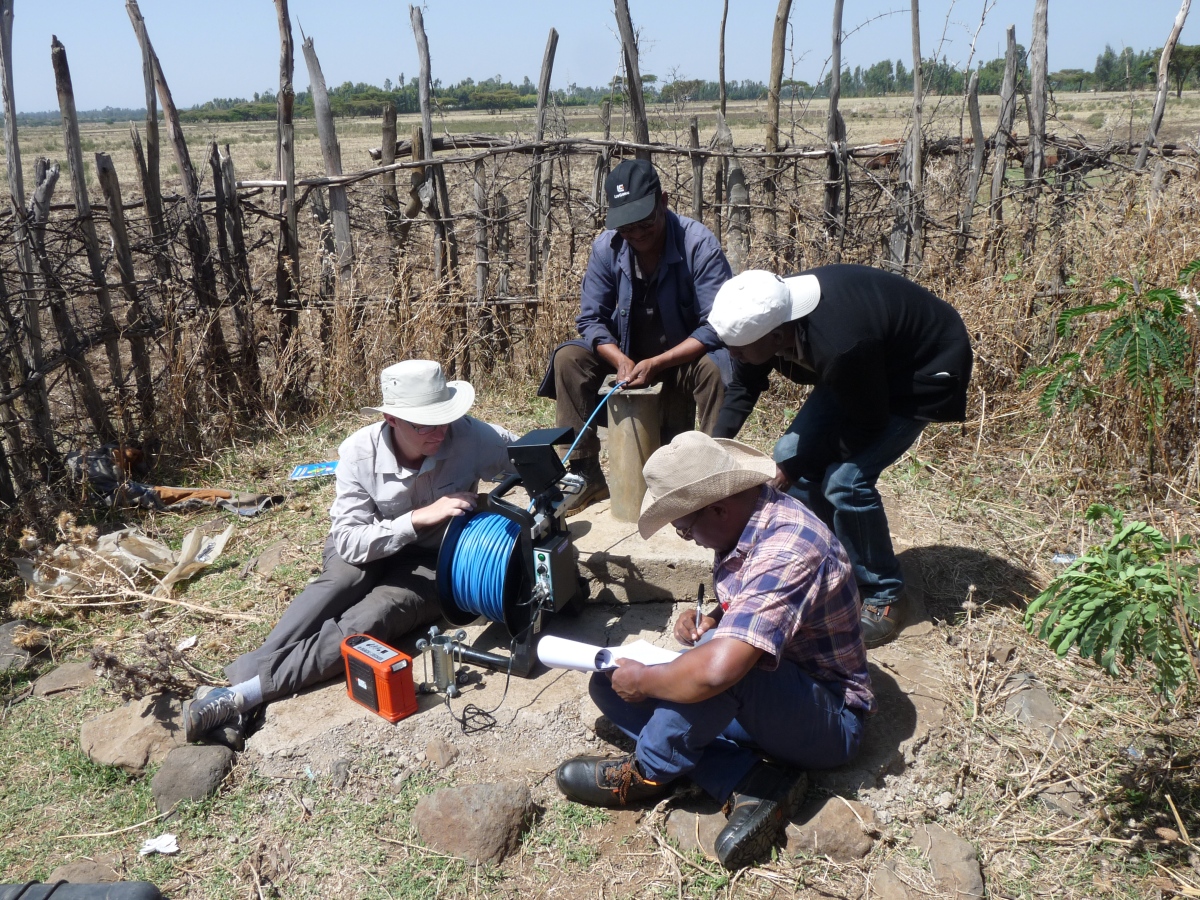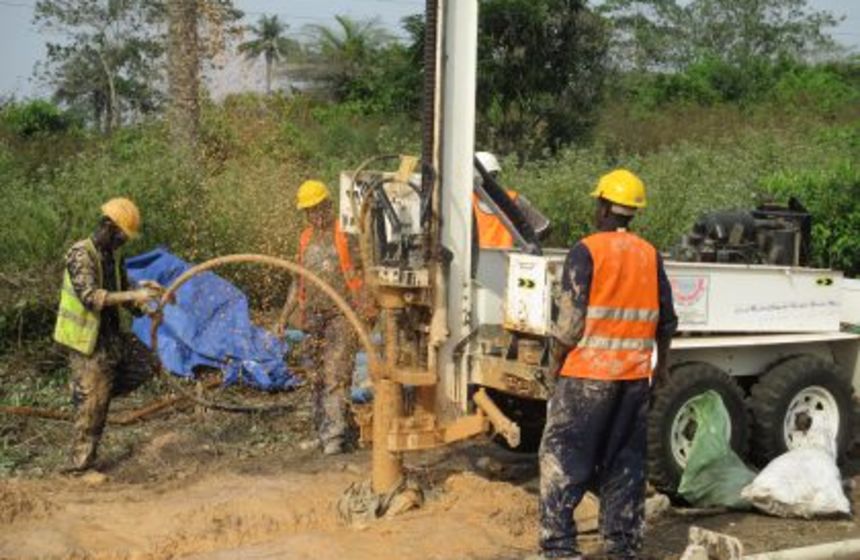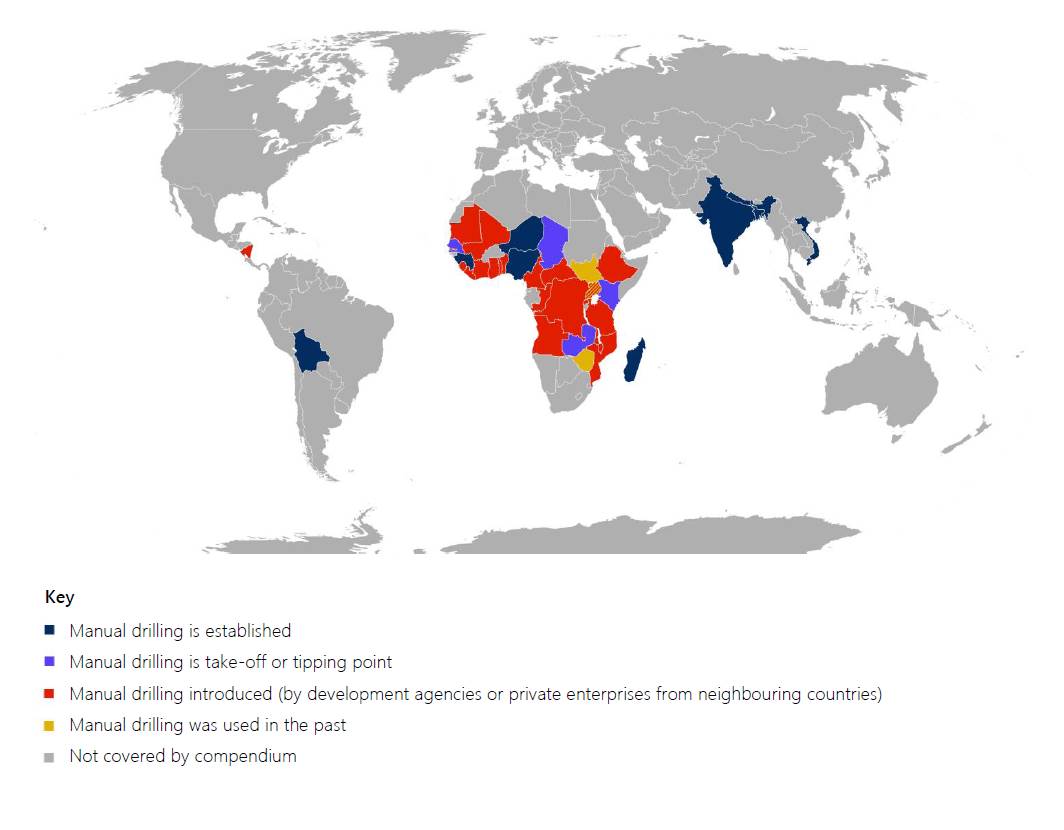Il s’agit du premier d’une série de quatre blogs intitulée ‘Le forage professionnel de puits d’eau: Apprendre de l’Ouganda” de Elisabeth Liddle et d’un webinaire en 2019 sur le forage de puits professionnel. Cette série s’appuie sur les recherches menées en Ouganda par Liddle et Fenner (2018). Nous vous invitons à nous faire part de vos commentaires en réponse à ce blog ci-dessous.
Les forages réalisés dans le cadre d’un “contrat clé en main ” sont devenus de plus en plus courants dans toute l’Afrique subsaharienne. Des recherches récentes menées en Ouganda par Liddle et Fenner (2018) ont montré que les contrats clés en main sont le type de contrat le plus courant lorsque le secteur privé fournit de nouveaux forages pour des pompes manuelles en milieu rural, bien que cela n’ait pas toujours été le cas. Dans ce blog, nous donnons un aperçu de ce que sont les contrats clé en main, pourquoi ils sont utilisés en Ouganda, et les avantages et les défis associés à leur utilisation en Ouganda.
Qu’est-ce qu’un contrat clé en main et pourquoi ces contrats sont-ils utilisés en Ouganda ?
Dans le cadre d’un contrat clé en main, un entrepreneur en forage est responsable à la fois de l’implantation et des travaux de forage et d’installation. Les contrats clés en main sont payés par le biais de modalités de paiement au forfait, c’est-à-dire “pas d’eau, pas de paiement “. Si le forage est fructueux, le foreur recevra la totalité du prix au forfait, quels que soient les coûts engagés sur place. Toutefois, si le forage est infructueux (forage à sec ou à faible rendement), le foreur ne sera pas payé du tout.
Les contrats clés en main ont pris de l’importance en Ouganda au milieu des années 2000 lorsque les agences d’exécution (autorités locales de district et Organisations Non Gouvernementales) devenaient de plus en plus frustrées par le nombre de forages infructueux réalisés lorsque les consultants effectuaient les travaux d’implantation de forages. Comme le consultant indiquait au foreur l’endroit où forer, si le forage échouait, l’agence de mise en œuvre devait payer le foreur pour tous les travaux effectués et les matériaux utilisés, c’est-à-dire selon un cahier des charges. L’échec des forages était imputé à la qualité du travail d’implantation des consultants ; de fait, les « consultants à mallette » (c’est-à-dire ceux qui n’avaient pas de formation officielle en géologie ou en hydrogéologie) avaient inondé le marché. En raison des bas prix qu’ils offraient et de l’absence de réglementation, ces consultants parvenaient à remporter des contrats d’implantation de forage.
Payer pour des forages infructueux était donc un problème, et il était devenu difficile pour les autorités locales de district d’atteindre leurs objectifs en matière de nouvelles sources d’eau potable. Les chefs de projet passaient pour incompétents. De plus, les responsables politiques ne comprenaient pas qu’un nombre de forages infructueux faisait partie intégrante du travail de forage ; par conséquent, si un foreur était payé pour un forage infructueux, les responsables politiques le considéraient comme corrompu. Certains responsables des services de l’eau au niveau du district ont même été menacés de prison.
La solution trouvée a été de retirer le consultant et de confier toute la responsabilité de la recherche de l’eau au foreur. Si le foreur forait alors un puits infructueux, il ne serait pas payé, car c’est lui qui était responsable de l’implantation du trou de forage. Le foreur prenait également tous les risques associés à un rendement d’eau inadéquat.
Avantages et défis de l’utilisation de contrats clés en main
Les contrats clés en main ont grandement simplifié le processus de passation de marché et de gestion de contrat pour les responsables de projets en Ouganda. Dans le cadre de contrats clés en main, les maitres d’ouvrage n’ont qu’à sélectionner et gérer un entrepreneur en forage. En outre, étant donné que le montant payé à l’entrepreneur si le forage est fructueux est déterminé au cours du processus d’appel d’offres, il n’y a pas de coûts imprévus pour le maitre d’ouvrage. De plus, en vertu des modalités de paiement « pas d’eau, pas de paiement », les organismes n’ont pas à dépenser directement de l’argent pour des forages infructueux ; l’argent n’est dépensé que pour des forages qui sont déclarés fructueux.
Bien que les contrats clés en main présentent des avantages notables, les chercheurs se sont entretenus avec plusieurs personnes en Ouganda qui se sont dites préoccupées par la qualité du travail :
- Le choix du site est fonction de la facilité à trouver de l’eau: Dans le cadre de contrats clés en main, les entrepreneurs de forage doivent trouver suffisamment d’eau pour être payés. De multiples entretiens ont confirmé que les entrepreneurs en forage forent des puits là où il semble plus facile de trouver de l’eau, par exemple dans les vallées ou près des marécages ou des rivières. Non seulement les entrepreneurs de forage sont extrêmement susceptibles de trouver de l’eau dans ces zones, donc d’être payés, mais ils forent souvent à des profondeurs beaucoup moins profondes que celles sur lesquelles leur estimation forfaitaire de coûts était basée. Une marge plus importante peut donc être réalisée dans ces conditions. Les forages situés dans ces zones sont toutefois vulnérables à la pollution. Bien qu’un forage puisse passer les tests de qualité de l’eau immédiatement après avoir été foré, l’eau peut être impropre à la consommation humaine pendant les mois pluvieux en raison de l’augmentation du transport des polluants de surface et des taux de lixiviation ou, après plusieurs années, du fait de l’accumulation des polluants dans ces zones. En outre, l’accès des communautés à ces puits peut être limité, en particulier pendant les mois pluvieux où ces zones peuvent être vulnérables aux inondations.
- Le bricolage pour faire des économies: En vertu des modalités de paiement « pas d’eau, pas de paiement »,, les entrepreneurs de forage doivent économiser dans la mesure du possible afin de pouvoir amortir les pertes qu’ils ont subies. Pour économiser de l’argent, il a été rapporté que certains entrepreneurs de forage en Ouganda sont connus pour les pratiques suivantes :
- L’utilisation de matériaux de mauvaise qualité et/ou qui ne sont pas appropriés qux conditions hydrogéologiques, par exemple, des conduites montantes en fer galvanisé plutôt qu’en acier inoxydable dans les eaux souterraines acides. Les conduites montantes en fer galvanisé sont 4 à 5 fois moins chères que l’acier inoxydable. Lorsque des conduites montantes en fer galvanisé sont utilisées dans les eaux souterraines acides (qui sont courantes en Ouganda), une eau de couleur rouge/brune impropre à la consommation humaine est fort probable (Casey et al., 2016).
- L’utilisation de matériaux inappropriés pour la conception du forage, par exemple, l’utilisation d’un tubage de 5 pouces lorsqu’un forage ouvert de 6/6,5 pouces[1] a été foré, car le tubage de 5 pouces est moins cher que celui de 6/6,5 pouces. Pour éviter que le tubage de 5 pouces ne tombe dans le trou ouvert de 6/6,5 pouces, les foreurs en chauffent la base et l’étirent pour l’ajuster au dessus de la zone ouverte. 42 % des entrepreneurs en forage interrogés (n = 14) ont admis avoir recours à cette pratique. Alors que certains y voient une bonne astuce, d’autres craignent que de la vase ne s’accumule dans ces forages avec le temps, en raison de l’espace entre le tubage et la roche consolidée et/ou des fissures qui se forment dans les zones les plus tendues du tubage. Un tel envasement use non seulement les pièces de la pompe à main, mais peut également entraîner des problèmes d’apparence du point de vue de l’utilisateur lorsque la vase pénètre dans l’alimentation en eau potable.
- Arrêter de forer lorsqu’on rencontre de l’eau pour la première fois: On peut économiser beaucoup d’argent ainsi ; en Ethiopie, par exemple, forer à 50 mètres au lieu de 60 mètres réduit le coût du forage de 13% (Calow et al., 2012). Toutefois, si le forage ne pénètre pas dans l’aquifère principal, la quantité d’eau disponible après la construction peut être problématique, même si le forage passe l’essai de pompage.
3) Interférer avec les données d’essai de la pompe ou raccourcir le temps d’essai de la pompe
Cela permet de masquer les sites à faible rendement et les sites infructueux. Ces forages seront inévitablement à faible rendement après construction ou, dans le pire des cas, à sec.
La nécessité pour les foreurs d’avoir recours aux pratiques ci-dessus en Ouganda est exacerbée par le fait que, dans de nombreux cas, le forfait auquel les foreurs sont payés pour un forage réussi n’est pas assez élevé. De plus, la supervision par un hydrogéologue qualifié est rare.
Que faire en ce qui concerne les contrats clés en main ?
Les contrats clés en main devraient-ils continuer à être utilisés en Ouganda ? Les avis diffèrent d’un acteur à l’autre : la majorité des maitres d’ouvrage en Ouganda estiment que le recours aux contrats clés en main devrait se poursuivre, tandis que les consultants et le Ministère de l’eau et de l’environnement estiment qu’ils devraient cesser, au vu des problèmes de qualité des travaux décrits ci-dessus.
Le Ministère de l’eau et de l’environnement est allé jusqu’à publier une directive en janvier 2017 décourageant l’utilisation de contrats clés en main, et préconisant plutôt que les contrats subdivisés, un pour le choix du site (attribué à un hydrogéologue/consultant) et un pour le forage et l’installation (attribué à un entrepreneur en forage) soient dorénavant utilisés. Les opinions des foreurs eux-mêmes semblent impartiales ; la plupart d’entre eux ne s’opposent pas à l’idée de travailler dans le cadre de contrats clés en main ; ils demandent simplement à ce que les prix forfaitaires que les maitres d’ouvrage soient prêts à payer pour des forages réussis augmentent dans le futur, pour qu’ils ne soient pas obligés de prendre de bricoler pour faire des économies sur place.
Qu’en pensez-vous?
Alors, qu’en pensez-vous? Avez-vous de l’expérience en matière de contrats clés en main pour forer des puits d’eau, ou d’autres pratiques que vous aimeriez partager ? Vous pouvez répondre ci-dessous en postant un commentaire, ou vous pouvez participer au webinaire en direct le 14 mai (inscriptions ici)
Références
Calow, R., MacDonald, A., and Cross, P. (2012). Corruption in rural water supply in Ethiopia. In J. Plummer (Ed.), Diagnosing Corruption in Ethiopia: Perceptions, realities and the way forward for key sectors (pp 121-179). Washington DC, USA: World Bank. Available from https://www.odi.org/sites/odi.org.uk/files/odi-assets/publications-opinion-files/8555.pdf
Casey, V., Brown, L., Carpenter, J.D., Nekesa, J., and Etti, B. (2016). The role of handpump corrosion in the contamination and failure of rural water supplies. Waterlines, 35(1), 59-77. Available from https://www.developmentbookshelf.com/doi/full/10.3362/1756-3488.2016.006
Liddle, E.S. and Fenner, R.A. (2018). Review of handpump-borehole implementation in Uganda, Nottingham, UK: BGS (OR/18/002). Available from https://nora.nerc.ac.uk/id/eprint/520591/
[1] Les trous de forage peuvent être ” entièrement tubés ” ou ” ouverts “. Si un trou de forage est ” entièrement tubé “, toute la partie verticale est tubée, avec des grilles dans les couches d’eau. Toutefois, si le trou de forage est ” ouvert “, seules les zones non consolidées du forage vertical sont tubées – le reste de la roche consolidée est laissé à l’état “ouvert ” (pas de tube ni de grilles).
Un pouce équivaut à 2,54 cm (note du traducteur).
Remerciements
Ce travail fait partie du projet Hidden Crisis du programme de recherche UPGro – cofinancé par le NERC, le DFID et l’ESRC.
Le travail de terrain entrepris pour ce rapport fait partie de la recherche doctorale des auteurs à l’Université de Cambridge, sous la supervision du Professeur Richard Fenner. Ce travail sur le terrain a été financé par le Ryoichi Sasakawa Young Leaders Fellowship Fund et UPGro : Hidden Crisis.
Merci à ceux d’entre vous de l’Université de Makerere et de WaterAid Ouganda qui m’ont apporté un soutien logistique, y compris sur le terrain, pendant que je menais les entretiens pour ce rapport (en particulier le Dr Michael Owor, Felece Katusiime et Joseph Okullo de l’Université Makerere et Gloria Berochan de WaterAid Uganda). Merci également à tous les répondants d’avoir été enthousiastes et disposés à participer à cette recherche.
Photo: ” Les membres de l’équipe Hidden Crisis utilisent une caméra de CCTV pour l’observation du fond de puits de la construction d’un forage communautaire ” (Source: ‘BGS © NERC. UPGro Hidden Crisis Project.’)



 Guest Blog by GIFT JASON WANANGWA
Guest Blog by GIFT JASON WANANGWA





 Course modules
Course modules



